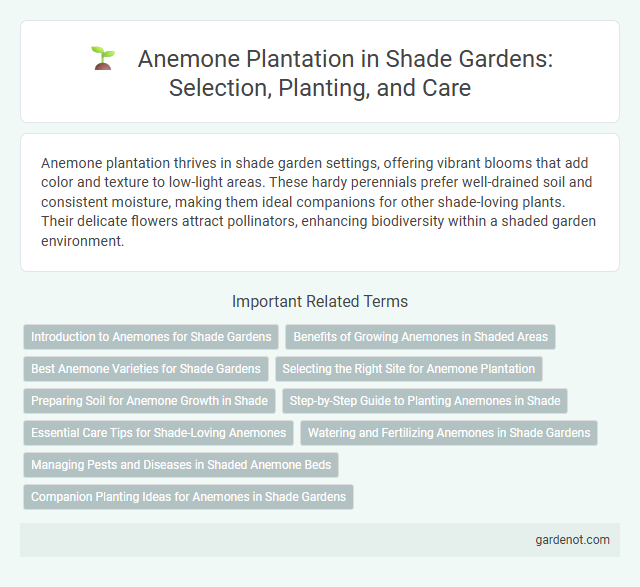Anemone plantation thrives in shade garden settings, offering vibrant blooms that add color and texture to low-light areas. These hardy perennials prefer well-drained soil and consistent moisture, making them ideal companions for other shade-loving plants. Their delicate flowers attract pollinators, enhancing biodiversity within a shaded garden environment.
Introduction to Anemones for Shade Gardens
Anemones thrive in shade gardens by preferring rich, well-drained soil and partial to full shade conditions. These resilient perennials bloom in late summer to fall, offering vibrant colors like white, pink, and purple that brighten shaded areas. Their adaptability to shade and low maintenance make anemones an ideal choice for creating dynamic, colorful woodland garden displays.
Benefits of Growing Anemones in Shaded Areas
Anemones thrive in shaded garden areas, offering vibrant blooms that brighten low-light environments while requiring minimal maintenance. Their ability to tolerate partial to full shade reduces competition with sun-loving plants, promoting diverse garden ecosystems. Growing anemones in shade gardens also helps improve soil health by enhancing organic matter through their root systems and fallen foliage.
Best Anemone Varieties for Shade Gardens
Anemone varieties such as Anemone nemorosa, Anemone blanda, and Anemone ranunculoides thrive exceptionally well in shade gardens, providing vibrant blooms in low-light conditions. These species exhibit adaptability to woodland environments and prefer well-drained, humus-rich soil, making them ideal for shaded landscape beds. Selecting cultivars like 'Robinsoniana' or 'Vestal' ensures prolonged blooming periods and enhanced color diversity, from whites and blues to soft pinks.
Selecting the Right Site for Anemone Plantation
Choosing the ideal location for anemone plantation involves selecting a shaded or partially shaded area that receives filtered sunlight to protect delicate blooms from harsh afternoon rays. Soils rich in organic matter with good drainage are essential to prevent root rot and encourage healthy growth. The site should maintain consistent moisture levels while avoiding waterlogged conditions to ensure vibrant, thriving anemone flowers.
Preparing Soil for Anemone Growth in Shade
Prepare soil for anemone growth in shade by ensuring it is rich in organic matter and well-drained to prevent waterlogging. Incorporate compost or aged manure to improve soil fertility and moisture retention, creating an ideal environment for root development. Maintain a slightly acidic to neutral pH level (6.0-7.0) to promote healthy anemone growth in shaded garden areas.
Step-by-Step Guide to Planting Anemones in Shade
Choose a well-drained, humus-rich soil with partial to full shade to ensure healthy anemone growth. Plant anemone tubers 1-2 inches deep and space them 4-6 inches apart, covering gently with soil and watering thoroughly to promote root establishment. Maintain consistent moisture and mulch heavily to retain soil temperature and moisture, supporting vibrant blooms in shaded garden areas.
Essential Care Tips for Shade-Loving Anemones
Shade-loving anemones thrive best in well-drained, moisture-retentive soil enriched with organic matter to mimic their natural habitat. Consistent watering is crucial, ensuring the soil remains evenly moist but not waterlogged, while avoiding direct sunlight protects these delicate perennials from foliage burn. Applying a balanced, slow-release fertilizer in early spring supports healthy growth and abundant flowering throughout the growing season.
Watering and Fertilizing Anemones in Shade Gardens
Anemones in shade gardens require consistently moist soil, so watering deeply once or twice a week ensures healthy growth without waterlogging. Applying a balanced, slow-release fertilizer in early spring supports vibrant blooms and robust foliage. Maintaining well-drained, nutrient-rich soil enhances the efficiency of both watering and fertilizing practices for optimal anemone development.
Managing Pests and Diseases in Shaded Anemone Beds
Effective pest and disease management in shaded anemone beds involves regular monitoring for common issues such as aphids, slugs, and powdery mildew. Utilizing natural predators like ladybugs and implementing organic treatments such as neem oil can help control infestations without harming the delicate shade environment. Maintaining proper air circulation and removing affected foliage promptly reduces the risk of fungal infections in these shaded garden settings.
Companion Planting Ideas for Anemones in Shade Gardens
Anemones thrive in shade gardens when paired with hostas, ferns, and astilbes, which provide complementary foliage textures and maintain the moist, well-drained soil conditions they prefer. Planting anemones alongside hellebores enhances seasonal interest since both bloom in early spring, offering staggered flowering periods that extend garden color. Incorporating woodland ivy or shade-tolerant groundcovers helps suppress weeds and retain soil moisture, benefiting the delicate anemone roots throughout the growing season.
Anemone plantation Infographic

 gardenot.com
gardenot.com